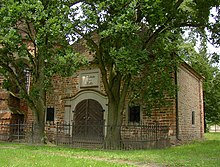Wust village church
The Protestant village church Wust is a Romanesque brick church in the district of Wust of the municipality of Wust-Fischbeck in the district of Stendal in Saxony-Anhalt . It belongs to the parish Wust in the parish Wulkow-Wust in the parish of Stendal of the Evangelical Church in Central Germany . It is a stop on the Romanesque Road .
History and architecture
The Wust village church is a flat-roofed brick building that was consecrated between 1191 and 1206 by the Havelberg bishop Helmbert. It is under the influence of the church of the Jerichow monastery and is closely related to the village church of Schönhausen (Elbe) . In contrast to these churches, however, it is not a basilica, but a hall church .
The church consists of a nave, a recessed square choir and a semicircular apse . The tower comes from the Baroque period and consists of a massive substructure the width of a ship and a two-storey half-timbered tower from 1727 with a curved dome . The baroque crypt of the von Katte family from 1708 adjoins the apse to the east . Lieutenant Hans Hermann von Katte , who was beheaded in 1730 and known for his close relationship with the future King Friedrich II of Prussia , is also buried in this crypt . The circumstances of his death and the crypt were received literarily by Theodor Fontane in his hikes through the Mark Brandenburg .
The Romanesque parts of the church are decorated with corner pilasters and corner friezes. The church is illuminated by arched windows that were later enlarged. There is an added round arch portal on the north side. The baroque transformation of the church was far-reaching, so that an exact reconstruction of the portals is not possible. It is possible that parts of the choir collapsed during the construction of the crypt annex, as indicated by the less careful masonry and the mutilated frieze on the north wall of the choir.
The church had fallen into disrepair since around 1930 and was due to be abandoned in 1970, but could be saved and restored by the small parish and the population from 1978 to 1981.
Furnishing
The church was furnished and equipped by Hans von Katte († 1684). The ship was given a coffered ceiling with painted angel chutes and rosettes with tenons at the corners of the frames. An octagonal field in the middle contains a representation of the Trinity .
A horseshoe-shaped gallery stretches around the ship, the panels of which are painted with angel heads. The wooden pulpit has a basket with twisted pillars. The pulpit altar is set up after prolonged use as a framework for the tomb of Hans von Katte again amid the apse. In the place of the pulpit there is now a crucifix flanked by palm trees, above the cornice are coats of arms, above a crucifixion image, putti and as a conclusion a carved representation of Christ.
The baptismal font is supported by a richly carved wooden tripod. The organ's prospectus (originally by Gottlieb Scholtze ) dates from 1756. A sandstone epitaph for Hans von Katte († 1716) with a three-dimensional representation of the deceased is set up on the south wall of the choir. A badly damaged epitaph for the early deceased Hans Heinrich von Katte († 1678) can be found on the north wall of the choir. Bronze bells from 1726 (Ulrich Brothers, Apolda) and 1806 (Christian Gotthold Ziegner, Magdeburg) set the bell.
literature
- Georg Dehio : Handbook of the German art monuments. Saxony Anhalt I. District of Magdeburg. Deutscher Kunstverlag, Munich / Berlin 2002, ISBN 3-422-03069-7 , pp. 1028-1029.
- Thomas Hartwig: All Altmark churches from A to Z . Elbe-Havel-Verlag, Havelberg 2012, ISBN 978-3-9814039-5-4 , p. 555 .
Web links
- Website of the Jerichow parish area
- Romanesque routes in Berlin and Brandenburg - Wust village church
- Website of the history circle and marionette stage
- The village church Wust in 90 pictures
Individual evidence
- ^ Damian Kaufmann: The Romanesque brick village churches in the Altmark and in the Jerichower Land. Verlag Ludwig, Kiel 2010, ISBN 978-3-86935-018-9 , pp. 446-447.
- ↑ Website of the Jerichow parish area. Retrieved February 27, 2018 .
Coordinates: 52 ° 32 '53.7 " N , 12 ° 6' 53.6" E


